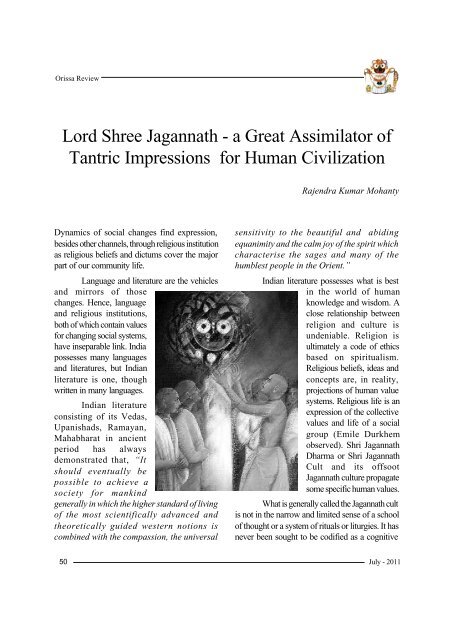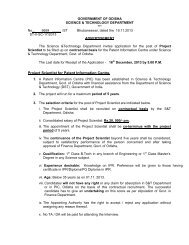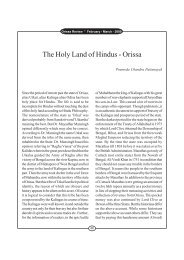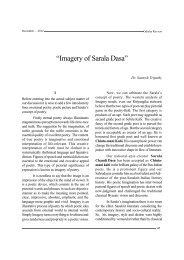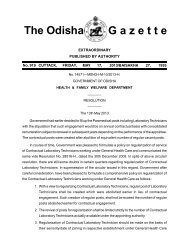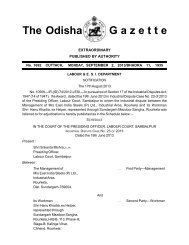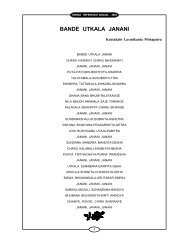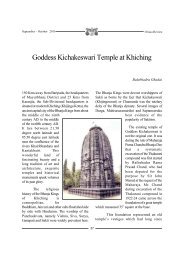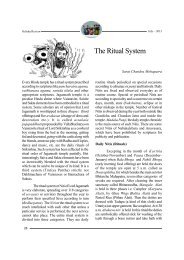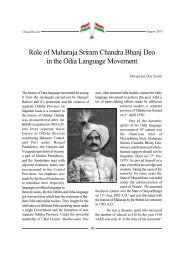Lord Shree Jagannath - a Great Assimilator of Tantric Impressions ...
Lord Shree Jagannath - a Great Assimilator of Tantric Impressions ...
Lord Shree Jagannath - a Great Assimilator of Tantric Impressions ...
You also want an ePaper? Increase the reach of your titles
YUMPU automatically turns print PDFs into web optimized ePapers that Google loves.
Orissa Review<br />
<strong>Lord</strong> <strong>Shree</strong> <strong>Jagannath</strong> - a <strong>Great</strong> <strong>Assimilator</strong> <strong>of</strong><br />
<strong>Tantric</strong> <strong>Impressions</strong> for Human Civilization<br />
Dynamics <strong>of</strong> social changes find expression,<br />
besides other channels, through religious institution<br />
as religious beliefs and dictums cover the major<br />
part <strong>of</strong> our community life.<br />
Language and literature are the vehicles<br />
and mirrors <strong>of</strong> those<br />
changes. Hence, language<br />
and religious institutions,<br />
both <strong>of</strong> which contain values<br />
for changing social systems,<br />
have inseparable link. India<br />
possesses many languages<br />
and literatures, but Indian<br />
literature is one, though<br />
written in many languages.<br />
Indian literature<br />
consisting <strong>of</strong> its Vedas,<br />
Upanishads, Ramayan,<br />
Mahabharat in ancient<br />
period has always<br />
demonstrated that, “It<br />
should eventually be<br />
possible to achieve a<br />
society for mankind<br />
generally in which the higher standard <strong>of</strong> living<br />
<strong>of</strong> the most scientifically advanced and<br />
theoretically guided western notions is<br />
combined with the compassion, the universal<br />
50<br />
Rajendra Kumar Mohanty<br />
sensitivity to the beautiful and abiding<br />
equanimity and the calm joy <strong>of</strong> the spirit which<br />
characterise the sages and many <strong>of</strong> the<br />
humblest people in the Orient.”<br />
Indian literature possesses what is best<br />
in the world <strong>of</strong> human<br />
knowledge and wisdom. A<br />
close relationship between<br />
religion and culture is<br />
undeniable. Religion is<br />
ultimately a code <strong>of</strong> ethics<br />
based on spiritualism.<br />
Religious beliefs, ideas and<br />
concepts are, in reality,<br />
projections <strong>of</strong> human value<br />
systems. Religious life is an<br />
expression <strong>of</strong> the collective<br />
values and life <strong>of</strong> a social<br />
group (Emile Durkhem<br />
observed). Shri <strong>Jagannath</strong><br />
Dharma or Shri <strong>Jagannath</strong><br />
Cult and its <strong>of</strong>fsoot<br />
<strong>Jagannath</strong> culture propagate<br />
some specific human values.<br />
What is generally called the <strong>Jagannath</strong> cult<br />
is not in the narrow and limited sense <strong>of</strong> a school<br />
<strong>of</strong> thought or a system <strong>of</strong> rituals or liturgies. It has<br />
never been sought to be codified as a cognitive<br />
July - 2011
or philosophical structure. If it has a looseness <strong>of</strong><br />
organization as a system <strong>of</strong> philosophy, if its<br />
liturgical or religious concepts have not been seen<br />
against the backdrop <strong>of</strong> any particular Hindu sect<br />
or sects to assess its deviations and differences<br />
from them, it is because, like Hinduism it is more<br />
<strong>of</strong> a cultural matrix than a systematic school <strong>of</strong><br />
philosophy or religion.<br />
It is in this sense that <strong>Jagannath</strong> cult is not<br />
a religion or philosophy but is a broad mythology<br />
<strong>of</strong> culture. The mythic process is a learning device<br />
in which the unintelligible and the random are<br />
reduced to an intelligible pattern, howsoever<br />
complex.<br />
If it is a system <strong>of</strong> rituals, then it is based<br />
on rituals as anti structures—a syndrome <strong>of</strong><br />
symbols that embraces almost the entire gamut<br />
<strong>of</strong> human emotions and endeavours.<br />
<strong>Jagannath</strong> culture which started with the<br />
worship <strong>of</strong> <strong>Lord</strong> Shri <strong>Jagannath</strong> is the oldest living<br />
culture <strong>of</strong> the world. This has a unique human -<br />
value- system which needs to be highlighted.<br />
Shri <strong>Jagannath</strong> culture believes in<br />
universality and not in sectarianism. Shri <strong>Jagannath</strong><br />
is the God <strong>of</strong> the masses and hence Shri <strong>Jagannath</strong><br />
culture has been a mass culture. People <strong>of</strong> diverse<br />
faiths have worshipped <strong>Lord</strong> Shri <strong>Jagannath</strong>. He<br />
has been worshipped by the primitive tribals,<br />
Dravidians, Aryans, Hindus, Jains, Buddhists,<br />
Sikhs, Shaktas, Shaivites, Ganapatas and<br />
Vaisnavites.<br />
<strong>Jagannath</strong> Culture has been an elastic<br />
culture. Apart from influencing other cultures, it<br />
has incorporated into its fold the cultures <strong>of</strong> various<br />
faiths. Shri <strong>Jagannath</strong> is the Saura’s, wooden<br />
Deity without sense organs. Again, He is the<br />
Dravidian Deity with sense organs. He is the<br />
Purusottama <strong>of</strong> the Vedas and Darubrahma <strong>of</strong> the<br />
Brahmins. His image smacks <strong>of</strong> the influence <strong>of</strong><br />
July - 2011<br />
Orissa Review<br />
Sauras. His rituals remind us <strong>of</strong> Dravidian customs<br />
and His festivals are <strong>of</strong> Puranic origin. Of his<br />
Mantras (incantations) OUM is Vedic and Hrim,<br />
Slim, Klim are <strong>Tantric</strong>. His Kaibalya is <strong>of</strong> Jain<br />
origin and Nirmalya is <strong>of</strong> Shaiva origin. A close<br />
observation <strong>of</strong> His worship, attire, food, rites and<br />
rituals make us conclude that Shri <strong>Jagannath</strong><br />
culture has assimilated features from other<br />
cultures. It is devoid <strong>of</strong>, and free from all types <strong>of</strong><br />
regional narrowness. The essence <strong>of</strong> all great<br />
religious scriptures can be perceived in Shri<br />
<strong>Jagannath</strong> culture. By its wonderful power <strong>of</strong><br />
assimilation, it has effected a synthesis <strong>of</strong> all the<br />
important cultures <strong>of</strong> the world. It has adapted<br />
itself to the varying environments by effecting<br />
changes in its outer form, but its essence remains<br />
unchanged.<br />
Tolerance is an outstanding human value<br />
propagated by Shri <strong>Jagannath</strong> culture. It tolerates<br />
all races, religions, customs, and cultures. This<br />
tradition <strong>of</strong> tolerance is not an attitude <strong>of</strong><br />
indifference towards others. This is a fundamental<br />
postulate <strong>of</strong> <strong>Jagannath</strong> culture that every way <strong>of</strong><br />
life has its own contribution to human welfare. It<br />
is this positive approach to other groups and<br />
communities- this eschewal <strong>of</strong> doctrine that one’s<br />
way is absolutely right which gives to <strong>Jagannath</strong><br />
culture <strong>of</strong> toleration its special significance.<br />
It has respect for the faiths and beliefs <strong>of</strong><br />
others and a generous charity <strong>of</strong> understanding<br />
the approaches <strong>of</strong> other people to the problems<br />
<strong>of</strong> life. It stands for religious tolerance, coexistence<br />
<strong>of</strong> all religious communal harmony and<br />
international integration. Hence Shri <strong>Jagannath</strong> is<br />
worshipped by all irrespective <strong>of</strong> caste, creed,<br />
colour and community. Shri <strong>Jagannath</strong> culture aims<br />
at bringing the entire human community <strong>of</strong> the<br />
world into the ambit <strong>of</strong> one family.<br />
The messages <strong>of</strong> unity, equality, peaceful<br />
-coexistence and fraternity are nowhere so<br />
51
Orissa Review<br />
obvious as in <strong>Jagannath</strong> culture. Shri <strong>Jagannath</strong><br />
Cult is said to be a splendid synthesis <strong>of</strong> Hinduism,<br />
Buddhism, Jainism and <strong>Tantric</strong> rites.<br />
Shri <strong>Jagannath</strong> is not just a deity, He is an<br />
unique institution. Here primitive cults merge with<br />
different Indian religious denominations, i.e.<br />
Jainism, Buddhism, Saivism <strong>Tantric</strong>ism,<br />
Vaishnavism etc. It is a towering spirit <strong>of</strong> synthesis<br />
- an amalgam <strong>of</strong> effects <strong>of</strong> imposed cults and<br />
cultures. It has become a symbol that accepts and<br />
embraces and assimilates everything and yet<br />
maintains its own character.<br />
The gap between man and Divine has<br />
been bridged in <strong>Jagannath</strong> culture. Shri <strong>Jagannath</strong><br />
is a highly humanized Deity. He brushes his teeth,<br />
takes bath, changes His clothes, wears different<br />
robes and gold ornaments studded with precious<br />
stones to suit different festive occasions and<br />
seasons, enjoys fifty six varieties <strong>of</strong> food (bhoga)<br />
and thirty six kinds <strong>of</strong> services “Khatani niyoga"<br />
and retires to bed in night. Social functions, like<br />
Deepavali, Payashraddha and Holi are held inside<br />
the Shri <strong>Jagannath</strong> Temple. In Summer, the <strong>Lord</strong><br />
takes cool bath in water mixed with sandalwood<br />
paste. During ‘Nabakalebara’, He leaves his old<br />
body and assumes a new one. His old body is<br />
cremated (by way <strong>of</strong> laying in ditches dug for the<br />
purposes) in “Koili Baikuntha”. Here, the<br />
conception <strong>of</strong> God is human and majestic.<br />
Shri <strong>Jagannath</strong> culture does not admit <strong>of</strong><br />
any distinction with regard to caste, creed, colour<br />
and sex. Here the Brahmin Pandit <strong>Jagannath</strong> Dash<br />
could become the disciple <strong>of</strong> the non-Brahmin<br />
devotee. Balaram Das, Achyutananda, Kayastha<br />
by caste could become the friend <strong>of</strong> Chaitanya a<br />
Brahmin. It has allowed inter-caste marriage even<br />
in the hoary past. The marriage <strong>of</strong> the Brahmin<br />
Vidyapati and Lalitha, the Saura girl (Indigenous<br />
Tribal girl) bears testimony to this fact. The<br />
descendants <strong>of</strong> this couple are called ‘Daitas’ and<br />
52<br />
they have got the monopoly to serve the Deities<br />
during ‘Anabasara’ every year.<br />
The Car Festival perhaps symbolises this<br />
liminal phase <strong>of</strong> the ritual system in which all<br />
powerful Gajapati Kings sweep the areas and<br />
space around pedestal (where upon <strong>Lord</strong>s sit) <strong>of</strong><br />
all three chariots before the swirling multitude and<br />
the <strong>Lord</strong> <strong>of</strong> the Universe leaves the Brahmin<br />
Servitors dominated cloistered seclusion <strong>of</strong><br />
sanctum sanctorium, the litanies <strong>of</strong> the nearly<br />
secret forms <strong>of</strong> a aristocratic worship, to sit on<br />
the wooden chariot in full view <strong>of</strong> the humble and<br />
the lowly and listen to their heartfelt but strange<br />
orchestra <strong>of</strong> private prayers and supplications.<br />
The achievement <strong>of</strong> a degree <strong>of</strong><br />
statuslessness by abolishing in one sweep <strong>of</strong> a<br />
symbolism all the multiple personal, group and<br />
class identity is, perhaps, the most significant<br />
aspect <strong>of</strong> Shri <strong>Jagannath</strong> Culture. It is based on a<br />
concept <strong>of</strong> submissiveness and silence that lifts<br />
grace to the levels <strong>of</strong> a mutual contract between<br />
the God-head and the individual.<br />
Shri <strong>Jagannath</strong> culture aims at the<br />
upliftment <strong>of</strong> the poor, the fallen and the<br />
downtrodden. Its <strong>Lord</strong> Shri <strong>Jagannath</strong> is called<br />
‘Patitapabana’, the saviour <strong>of</strong> the fallen. Leaving<br />
behind His golden throne in ‘Bada Deula’ (His<br />
abode called Shri <strong>Jagannath</strong> Temple), He comes<br />
into ‘Badadanda’ (i.e, Grand Road connecting<br />
Shrimandira and Gundicha Temple (temporary<br />
abode during Car Festival). He comes into Grand<br />
Road twice in a year during car festival and<br />
Bathing Ceremony in order to be in the midst <strong>of</strong><br />
His devotees. This is a rare thing which is unique<br />
to this culture. In other cultures, devotees go to<br />
the temple or Shrine <strong>of</strong> the <strong>Lord</strong> to <strong>of</strong>fer their<br />
prayers. But here, the ever compassionate <strong>Lord</strong><br />
comes out twice a year to help His devotees and<br />
to be with them. Anybody can draw the ropes <strong>of</strong><br />
his chariots and can take ‘Mahaprasad’, the<br />
July - 2011
cooked food cooked in the sacred kitchen <strong>of</strong> Shri<br />
<strong>Jagannath</strong> inside the inner circle <strong>of</strong> the <strong>Great</strong><br />
Temple which has been <strong>of</strong>fered to Him.<br />
Humbleness is a cardinal human value in<br />
Shri <strong>Jagannath</strong> culture. Superiority complex and<br />
class-consciounsness have no place here. This<br />
culture ordains that no work is high or low. Here,<br />
the Gajapati king sweeps the chariots <strong>of</strong> the<br />
Deities. No doubt, this is a symbolic act. This act<br />
signifies that in Shri <strong>Jagannath</strong> Culture, there is<br />
no distinction between the powerful Sovereign<br />
King and the lowest <strong>of</strong> the low. Here, Shri<br />
<strong>Jagannath</strong> Himself imparts the lesson <strong>of</strong><br />
humbleness. During the ‘Pahandi’ (i.e, when the<br />
Deities are coming down the twenty two steps <strong>of</strong><br />
the temple one after another to sit in chariots) the<br />
<strong>Lord</strong> ungrudgingly tolerates the kicks and<br />
fisticuffs, slaps and derogatory comments <strong>of</strong> His<br />
Servitors. He behaves like a commoner, pledges<br />
his golden ring and quenches His thirst by taking<br />
curd from a milk-maid. He protests against the<br />
pride and arrongance <strong>of</strong> the Brahmin servitors /<br />
priests by accepting a coconut from the hand <strong>of</strong><br />
an untouchable, namely Dasia Bauri. He does not<br />
distinguish between the Gajapati king, His first<br />
Servitor among the rest <strong>of</strong> the Servitors and a<br />
‘Daitapati’ (a non Brahmin, but very close Servitor<br />
<strong>of</strong> the Deity) or between a Brahmin Servitor and<br />
an untouchable devotee.<br />
Naturally enough Orissa’s glorious<br />
Gajapati Kings treated their sprawling empire as<br />
no more than a Trust from Him, to be looked<br />
after in correct conscience, themselves being only<br />
its humble care-takers. When they returned<br />
victorious from military expeditions which were<br />
almost day to day affairs in those spacious times,<br />
they surrendered all their precious spoils to Him<br />
as rightly His. And to the innumerable feudal chiefs<br />
<strong>of</strong> the Empire, there was no greater moral curbs<br />
to any kind <strong>of</strong> treasonable thought or behaviour<br />
July - 2011<br />
Orissa Review<br />
against the Temporal Power, i.e, Central Power<br />
than the fear <strong>of</strong> dire divine retribution from the<br />
Omnipotent <strong>Lord</strong> <strong>of</strong> the Universe, i.e, Shri<br />
<strong>Jagannath</strong>.<br />
If the <strong>Lord</strong> spiritual thus helped and cooperated<br />
with Orissa’s <strong>Lord</strong> Temporal in the<br />
down-to-earth daily matters <strong>of</strong> administration, he<br />
was never any distance away also from Orissa’s<br />
frequent military expedition to neighboring land.<br />
If the Oriyas won glorious military triumphs over<br />
all their national enemies for over, twenty centuries<br />
continuously, king <strong>of</strong> the-then Orissa and Chiefs<br />
<strong>of</strong> military staff were wise enough not to arrogate<br />
all that glory entirely to their brawn, arms, courage<br />
or their skills in combat deployments, but<br />
attributed all that to the graces flowing out <strong>of</strong> Shri<br />
<strong>Jagannath</strong>’s Lotus Feet.<br />
The legend so widespread in Orissa and<br />
immortalised in painting, sculpture and poetry <strong>of</strong><br />
Shri <strong>Jagannath</strong> and His elder brother Shri<br />
Balabhadra, riding on black and white horses,<br />
ahead <strong>of</strong> king Purusottam’s Oriya army, marching<br />
to wreck vengeance on the impudent Prince <strong>of</strong><br />
Kanchi, is nothing but only the symbolic<br />
mystification <strong>of</strong> this universal feeling <strong>of</strong> the Oriya<br />
people that the great <strong>Lord</strong> Shri <strong>Jagannath</strong> was an<br />
active participant in all their national as well as<br />
personal affairs and that whatever prosperity that<br />
fell to them either as a nation or as individuals,<br />
was surely, merely His grace.<br />
Shri <strong>Jagannath</strong>, among all the Gods and<br />
Goddess <strong>of</strong> the Hindu Pantheon, is the God <strong>of</strong><br />
Democracy, par excellence. He alone, unlike all<br />
other divine celebrities <strong>of</strong> this great sub continent,<br />
was born out <strong>of</strong> the spiritual aspiration <strong>of</strong> the<br />
common man. He came to Orissa’s illiterate and<br />
unsophisticated Sabara tribals (Indigenous people<br />
residing in Orissa from hoary past as original<br />
inhabitants) in the dim past, when perhaps even<br />
the earliest chants <strong>of</strong> the great Rig Veda were not<br />
53
Orissa Review<br />
heard or known. He appeared also, on the same<br />
place <strong>of</strong> existence as that <strong>of</strong> His devotees, gladly<br />
accepting an open air habitat under a forest tree,<br />
along with crude food <strong>of</strong> His simple worshippers,<br />
He has kept up, through centuries, that kinship<br />
with the common folk in the midst <strong>of</strong> royal luxuries<br />
that were showered on Him later on, demanding,<br />
through the annual Car Festival, close association<br />
<strong>of</strong> the descendants <strong>of</strong> most pre-historical Sabaras<br />
devotees <strong>of</strong> His and remaining content with<br />
uncooked food such as the latter <strong>of</strong>fered Him in<br />
His forest hideout on a green look hillock on the<br />
bank <strong>of</strong> the river Mahanadi (Green look hillock<br />
is the present site <strong>of</strong> Shri <strong>Jagannath</strong> Temple which<br />
is in much higher height in comparison to<br />
peripheral sites, and the river Mahanadi in hoary<br />
past was flowing around this hillock and falling in<br />
lake Chilka, as geographical study by Tolemi has<br />
established) <strong>Lord</strong> Shri <strong>Jagannath</strong> stands as a<br />
spectacular symbol <strong>of</strong> National Integration, the<br />
free India’s most burning problem. Blue stone that<br />
the Sabaras had picked-up is supposed to be the<br />
fossilised un-burnt heart <strong>of</strong> Shrikrushna, thrown<br />
into waves <strong>of</strong> the western sea coast that had flown<br />
all along the Indian-sea board, to rest at last, on<br />
Odishan soil.<br />
In the above interesting myth, we clearly<br />
see an attempt at a spiritual link up <strong>of</strong> the entire<br />
Indian subcontinent from sea (western coast) to<br />
sea (eastern coast). If Shri <strong>Jagannath</strong> is Shrikrishna<br />
as well as Shri Ram, He also is the Buddha, as<br />
the Ninth Avtar (incarnation) <strong>of</strong> Shri Vishnu.<br />
In His daily worship, the blue-blooded<br />
Brahmin Servitor daily rubs his fair shoulders with<br />
the transformed, but still dark-skinned aboriginals<br />
(i.e, Daitas, Suddha Suara, etc.) thus putting into<br />
daily practice , the most vital line <strong>of</strong> king Ashoka<br />
in his famous Kalinga edicts- “saba manisa me<br />
puja”- all human beings are like my own dear<br />
children.<br />
54<br />
Shri <strong>Jagannath</strong> Culture always takes a<br />
positive view <strong>of</strong> life. It does not admit <strong>of</strong> the<br />
pessimistic thoughts <strong>of</strong> grief, suffering and death.<br />
It recommends staunch faith in the Divine. It<br />
teaches man to strive for the perfection <strong>of</strong> his soul<br />
by the sacrifice <strong>of</strong> His self. Material pursuits find<br />
no place in this culture. Here, a devotee does not<br />
ask for anything material. He prays for Divine<br />
love and grace.<br />
Shri <strong>Jagannath</strong> is the ocean <strong>of</strong> Mercy. By<br />
his Divine benediction He can liberate us and take<br />
us out <strong>of</strong> our mortal existence to the Divine abode.<br />
Unflinching faith in the <strong>Lord</strong> will kill all mundane<br />
desires and elevate the human soul. Shri <strong>Jagannath</strong><br />
culture teaches us that faith in the <strong>Lord</strong> and selfless<br />
service in the world will bring redemption to<br />
mankind.<br />
Shri <strong>Jagannath</strong> culture has effected unity<br />
in diversity and integrated human society with the<br />
help <strong>of</strong> human values that we have seen earlier as<br />
discussed in preceding paragraphs. This culture<br />
could come through many ups and downs.<br />
Surviving many onslaughts, it has consolidated its<br />
position and proved itself to be an effective and<br />
ideal culture.<br />
Human values such as tolerance, fellow<br />
feeling, unity, equality, fraternity, modesty and self<br />
sacrifice contained in Shri <strong>Jagannath</strong> Culture have<br />
sustained and will continue to sustain human<br />
civilization in our planet.<br />
Thus National Integration has been a<br />
reality in practice for centuries with Shri <strong>Jagannath</strong><br />
though it might be much talked <strong>of</strong> now at Guahati<br />
or Shri Nagar or at Chennai or at Delhi with<br />
hypocritical loudness.<br />
Rituals are as old as human civilization.<br />
When man made the first query about himself, he<br />
found to his utmost surprise that he was an<br />
admixture <strong>of</strong> some thing awful, ferocious and<br />
July - 2011
something benign and serene. The life force in him<br />
incited him to believe in a superior force behind<br />
the vast universe. This thought ultimately<br />
culminated, in “Pinda - Brahmanda” theory <strong>of</strong><br />
the Tantras and a unification <strong>of</strong> the supreme self<br />
and the individual self in the thought - “Yatha dehe,<br />
tatha Deve” (i.e whatever is in body is there in<br />
Deity)- forming the basis <strong>of</strong> the psychology <strong>of</strong> all<br />
worships. According to ‘Pinda- Brahmanda’<br />
theory, human body is a microcosm <strong>of</strong> the Universe<br />
or Brahmanda’. The “Visvasa ra Tantra’ says,<br />
‘Whatever is here (in this body) is also there (i.e,<br />
in the Universe). The five elements constituting<br />
the body are in no way different from the cosmic<br />
elements, i.e,. “Pancha Mahabhutas”, constituting<br />
the Universe. The body has a mind and the spirit<br />
and universal body has also a cosmic mind ritam<br />
comprising <strong>of</strong> three tendencies Ichha, Jnyana and<br />
Kriya, at the root <strong>of</strong> all evoluation and the Supreme<br />
Spirit, the Super Consciousness pervading the<br />
entire Universe. According to Hindu scriptures,<br />
the individual self may be able to realise the<br />
Supreme Spirit provided the enveloping mind and<br />
body are removed from it giving it a separate and<br />
finishing dimension otherwise, called “Avidya”.<br />
This Avidya also has its source in the Supreme<br />
Self as there cannot be anything in the Pinda which<br />
is not there in the Supreme Self or Brahma, is<br />
may or a finitising factor in the supreme<br />
consciousness which appears in the primordial<br />
cause <strong>of</strong> all ‘Prapancha’, the world or the<br />
Universe. Similarly mind in the individual body is<br />
the cause <strong>of</strong> all fetters <strong>of</strong> the Soul in its realization<br />
<strong>of</strong> the Brahman. The fetters are to be removed.<br />
And what is this way ?<br />
Man has pondered over it through all ages<br />
since the dawn <strong>of</strong> civilization and the Indian<br />
thinkers have shown that the path to know<br />
Brahman is to be Brahman. How ? The <strong>Lord</strong> is<br />
pure, infinite spirit, in this aspect to the relative<br />
world as its Creator, Maintainer and Destroyer.<br />
July - 2011<br />
Orissa Review<br />
Man is the selfsame spirit and in one aspect is<br />
immutable and in another is finitised by Mind and<br />
Matter. Mind, though an unconscious force,<br />
appears to be conscious as described by<br />
Vedantists, because it is the vehicle <strong>of</strong> Spirit which<br />
is consciousness itself. Once mind is detached<br />
from this body and finitising matter, it is merged in<br />
spirit and spiritualised as an iron rod becomes<br />
red-hot fire in a blacksmith’s furnace. Hence, for<br />
the realization <strong>of</strong> the Supreme Spirit, mind has a<br />
very vital role to play. When the individual self<br />
wants to concentrate on this Supreme Self, a mindray<br />
projected from the mind which goes forth to<br />
the object <strong>of</strong> worship, be it an image, or an idol,<br />
or a yantra, or a mere idea and takes its form,<br />
and returns and models the mind itself into the<br />
form <strong>of</strong> the object. Thus, by constant and<br />
complete attention on the form <strong>of</strong> the <strong>Lord</strong> without<br />
distraction, the mind transformed into the shape<br />
<strong>of</strong> the object in the form <strong>of</strong> the <strong>Lord</strong>. Thus, mind<br />
acquires the qualities <strong>of</strong> the <strong>Lord</strong> by such<br />
concentration being shaped into this image <strong>of</strong> the<br />
<strong>Lord</strong>.<br />
This is the basis <strong>of</strong> all worships, a method<br />
adopted by all devotees <strong>of</strong> the world whatever<br />
may be their caste, creed or birth, to realize God.<br />
And because mind and body have a common<br />
origin, the one as subject can know the other as<br />
object. Cognition is then recognition. The same<br />
power which has the capacity to veil itself can<br />
unveil itself to the seeker or the worshipper. How<br />
is that worship or Upasana to be made? Its first<br />
design is to secure that the mind shall have a good<br />
object as the symbol <strong>of</strong> God before it for<br />
concentration. In case <strong>of</strong> Upasana <strong>of</strong> <strong>Lord</strong> Shri<br />
<strong>Jagannath</strong>, object <strong>of</strong> Upasana or worship is <strong>Lord</strong><br />
<strong>Jagannath</strong> Himself. Taking into cognition <strong>of</strong> facts<br />
prevailing in Pre-Vedic and pre - Mahabharat in<br />
Udra Rajya or the modern day Orissa, it is the<br />
Lady deity which predominates into the worship<br />
<strong>of</strong> <strong>Lord</strong> <strong>Jagannath</strong> into a particular mode which<br />
is known as Dakshina Kalika.<br />
55
Orissa Review<br />
The mode <strong>of</strong> worship or Upasana <strong>of</strong> Shri<br />
<strong>Jagannath</strong> is unique and different from that <strong>of</strong> other<br />
Hindu Temples in North or South India. His Puja<br />
or worship has been well developed and<br />
systematised in a well designed process by<br />
coordinating the basics <strong>of</strong> Vedic, <strong>Tantric</strong>,<br />
Vaishnavite, Puranic streams.<br />
Hindu scriptures prescribe three main<br />
streams for Puja <strong>of</strong> Hindu Deities, i.e, Nigam ,<br />
Agam and Lokachara. Nigam is pure Vedic<br />
system. Agam is pure <strong>Tantric</strong> system and<br />
Lokachara is combination <strong>of</strong> both Nigam and<br />
Agam and some locally adjusted system prevalent<br />
for many years.<br />
Nigam system is guided by Karmakanda<br />
which concentrates mainly on “Japa”, “Jaaga” and<br />
“Yagyan” (fire sacrifice), where as Agam system<br />
is very much elaborate and contains innumerable,<br />
but prescribed (as in <strong>Tantric</strong> Literatures) systems<br />
<strong>of</strong> Puja. Agam means it is that which has come<br />
out <strong>of</strong> the mouth <strong>of</strong> Shiva, that which has entered<br />
into the mouth <strong>of</strong> Mahamaya Uma and that which<br />
is the opinion <strong>of</strong> Vishnu. <strong>Tantric</strong> system is a means<br />
for overall development <strong>of</strong> human beings and<br />
human society. Tantra aims to transform every<br />
action in life into a ritual, so that the individual<br />
performs every action and thought with a feeling<br />
<strong>of</strong> worship and awareness. The action <strong>of</strong> bathing,<br />
dressing, sitting for worship, <strong>of</strong>fering various<br />
symbolic sacrifices, sexual relations, stages <strong>of</strong><br />
development from conception in the womb, to<br />
birth and marriage etc. are transformed into<br />
worship. <strong>Tantric</strong> system has seven number <strong>of</strong><br />
“Acharas” (mythology <strong>of</strong> Upasana), out <strong>of</strong> which<br />
“Dakhinachara” as well as “Kulachara” are most<br />
suitable for Vaishnavite <strong>Tantric</strong> Upasana.<br />
In <strong>Tantric</strong> Upasana, Yantra and Mantra<br />
play major roles. “Yantra” is the body <strong>of</strong> the Deity.<br />
Puja <strong>of</strong> a Deity is required to be taken up on a<br />
Yantra, so Yantra is definitely very important<br />
56<br />
“Sarbeshameb Devanam Yantrapuja<br />
Prasasashyate” (“Gautami Tantra”) without a<br />
Yantra, Puja cannot be undertaken. If the<br />
“Yantra” is not known, then eight-petalled lotus<br />
is to be undertaken accordingly.<br />
“Mantra” is the soul <strong>of</strong> the Deity on a<br />
“Yantra” (“Mantra yate guptam Paribhasa te iti<br />
Mantrah”). Mantra is secret, to be learnt from a<br />
perfect “Guru” (Master). The sound <strong>of</strong> the<br />
Mantras being chanted combined with the power<br />
<strong>of</strong> the resolve made by the person performing the<br />
Puja, reaches the divine power that converts the<br />
chants into the desired blessings.<br />
Mantras in a gross level are special sound<br />
patterns. On a deeper sense, they are much more.<br />
Mantras are most important and considered as<br />
the essence <strong>of</strong> the practical Tantra. Mantras and<br />
Yantra (i.e., Mandals) are utilised in conjunction<br />
with each other to form a powerful combination.<br />
A Mandala, a Yantra or a Devata is the form <strong>of</strong><br />
consciousness. The Mandalas, or Yantras or<br />
Devatas are the manifested form, configuration<br />
<strong>of</strong> “Shakti”, while, the “Mantra” which is also<br />
“Shakti”, is the link between consciousness and<br />
form. This system applies to everything in the<br />
world around us. The visible form is the<br />
expression, while the Mantra is the vehicle <strong>of</strong><br />
expression. Mantra is the direct link with the<br />
beyond.<br />
Taking into cognition <strong>of</strong> all the historical,<br />
archaeological and Puranic facts into<br />
consideration which are available at least from<br />
first century AD, it can safely be stated that Shri<br />
<strong>Jagannath</strong> Upasana is nothing but a ‘<strong>Tantric</strong><br />
Upasana’ <strong>of</strong> Vajrayana Period (<strong>Tantric</strong> Buddhist<br />
rituals which originated from Orissa during 3rd /<br />
4th century and went on spreading to India. Tibet<br />
and beyond through the Guru Padmasambhaba<br />
who happened to be the son <strong>of</strong> King ascertic<br />
Indrabhuti, King <strong>of</strong> the then Sambalaka (modern<br />
July - 2011
day Sambalpur) which is amply proved from<br />
the seats <strong>of</strong> the idols which are Yantras <strong>of</strong> various<br />
type. <strong>Lord</strong> Shri <strong>Jagannath</strong> sits on Kali Yantra,<br />
Balabhadra on Tara-yantra, Subhadra on<br />
Bhubaneswari - Yantra and the Mantras adopted<br />
for their worship should also be studied. Though<br />
these Mantras have been widely corrupted by<br />
subsequent additions and interpolations, the basic<br />
Vija Mantras appear to be <strong>Tantric</strong> and not Vedic.<br />
The <strong>Lord</strong> Shri <strong>Jagannath</strong> is worshipped by the<br />
following Mantra. “Klim Krishnaya, Govindaya<br />
Gopijana Vallabhaya Svaha”. It is undoubtedly a<br />
fact that except the primary vija Mantra ‘Klim’,<br />
the other portion <strong>of</strong> the Mantra is a Chaitanitic<br />
addition whose creed overwhelmed the then<br />
Oriya religious thoughts and culture due to royal<br />
patronage at the time <strong>of</strong> Gajapati king Pratap<br />
Rudra Dev and naturally the seat <strong>of</strong> Oriya Culture,<br />
i.e, Shri <strong>Jagannath</strong> <strong>of</strong> Puri adopted the religion <strong>of</strong><br />
the king with consequential changes.<br />
What is this ‘Klim’ which is the Vija<br />
Mantra for worship <strong>of</strong> <strong>Lord</strong> Shri <strong>Jagannath</strong>?<br />
Actually, Klim is the Vija Mantra <strong>of</strong> Sakta Tantrik<br />
Deity Kali and very <strong>of</strong>ten <strong>Lord</strong> Shri <strong>Jagannath</strong><br />
has been described as ‘Dakshina Kalika’ (in<br />
‘Mahanirvana Tantra’).<br />
Influence <strong>of</strong> <strong>Tantric</strong> way <strong>of</strong> Puja in case<br />
<strong>of</strong> <strong>Lord</strong> Shri <strong>Jagannath</strong> can be well observed from<br />
various Nyasas such as “Sadanga-Nyasa”,<br />
“Keshavadi Nyasa”, “Shrikanthadi Nyasa”,<br />
“Kala-Nyasa”, “Matruka-Nyasa”, “Sodha-<br />
Nyasa” and “Mahasodha Nyasa” which are<br />
attributed in daily mode <strong>of</strong> worship <strong>of</strong> <strong>Lord</strong> Shri<br />
<strong>Jagannath</strong>.<br />
Moreover, “Panchasakhas” (five friends),<br />
i.e., Balaram Das, Ananta Das, Yasobanta Das,<br />
Achyutananda Das and <strong>Jagannath</strong> Das are all<br />
Vaishnavites and their presiding Deity is Shri<br />
<strong>Jagannath</strong> <strong>of</strong> Puri, Purusottam Khetra. But they<br />
are all devotees <strong>of</strong> <strong>Lord</strong> Shri <strong>Jagannath</strong> in a <strong>Tantric</strong><br />
July - 2011<br />
Orissa Review<br />
mode (i.e., Kaula- charies). We find mention <strong>of</strong><br />
Yantra, Mantra and Tantra in their literatures.<br />
According to them, <strong>Lord</strong> Shri <strong>Jagannath</strong> is both<br />
“Saguna Brahma” and “Nirguna Brahma”. Yantra,<br />
Mantra, Tantra are nothing but “Saguna Sadhana”.<br />
According to them, one can realise Shri <strong>Jagannath</strong><br />
in his own body by both Saguna Sadhana and<br />
Nirguna Sadhana which is famous as “Pinda -<br />
Brahmanda Tatwa or Theory” which has been<br />
delineated in earlier paragraphs.<br />
Besides, the following daily rituals would<br />
show that the articles <strong>of</strong>fered to the <strong>Lord</strong> are<br />
symbols <strong>of</strong> five M’s <strong>of</strong> the Tantra Dakshinachara<br />
worship. In the morning, cocoanut water is <strong>of</strong>fered<br />
to <strong>Lord</strong> Shri <strong>Jagannath</strong> and Madan Mohana<br />
(moveable representative Deity <strong>of</strong> Shri <strong>Jagannath</strong>)<br />
in a Kansya-Patra, i.e bell metal pot or water with<br />
Jaiphala thrashing in an earthen pot as a symbol<br />
<strong>of</strong> wine. This is also <strong>of</strong>fered during day’s <strong>of</strong>fering<br />
<strong>of</strong> Panktibhoga. Similarly <strong>of</strong>fering <strong>of</strong> black gram<br />
(biri) cakes admixtured with Hengu is made as a<br />
symbol <strong>of</strong> flesh <strong>of</strong>fering. Offering <strong>of</strong> various green<br />
Sakas (lettuce) with ginger (ada) and ‘hengu’ are<br />
made as a symbol <strong>of</strong> fish. Offering <strong>of</strong> various<br />
cereals are made as symbol <strong>of</strong> Mudra. At times,<br />
Mudra is identified with various gestures <strong>of</strong> hand<br />
while <strong>of</strong>ferings are made to the Deity. The last<br />
<strong>Tantric</strong> symbol <strong>of</strong> worship is Maithuna or<br />
copulation. This may appear odd but, it was<br />
symbolically represented by Mahari or Devadasi<br />
dances (till 1956) in the Shri <strong>Jagannath</strong> Temple at<br />
the time <strong>of</strong> sleep <strong>of</strong> the <strong>Lord</strong> at night. These dances<br />
were <strong>of</strong>fered to the <strong>Lord</strong> by an unmarried girl in a<br />
semiclad body in a trance position. The system is<br />
no more prevalent, as no unmarried girl is<br />
available who would remain unmarried for whole<br />
life in order to perform Devadasi Nrutya before<br />
<strong>Lord</strong> Shri <strong>Jagannath</strong> alone. Even <strong>Lord</strong>s are<br />
dressed like women by wearing Saries with veils<br />
head dresses <strong>of</strong> women and nose-rings at the time<br />
<strong>of</strong> worship.<br />
57
Orissa Review<br />
These methods <strong>of</strong> worship verily show<br />
that the <strong>Lord</strong> Shri <strong>Jagannath</strong> and the attendant<br />
Deities Shri Balabhadra and Shri Shubhadra are<br />
being worshipped in the <strong>Tantric</strong> way although time<br />
has admixtured it with Vedic Homa and Achamana<br />
and <strong>of</strong>fering <strong>of</strong> Arghya, Puspa and Chandana and<br />
other cosmetics and local adaptations <strong>of</strong> various<br />
<strong>of</strong>fering unprecedented in Vedas, Tantras and<br />
Puranas. But, invariably a question may arise as<br />
to why such <strong>of</strong>fering are made symbolically and<br />
not in actuality.<br />
The Tantras have explained it very<br />
elaborately. Worship (i.e, Upasana) may be<br />
‘Tamasika’ ‘Rajasika’ or ‘Sattvika’ in accordance<br />
with the competence <strong>of</strong> the worshippers who may<br />
be divided into three classes as ‘Pasus’, ‘Viras’<br />
and ‘Divyas’. The Pasus belong to the lower order<br />
<strong>of</strong> worhippers who are restrained from use <strong>of</strong><br />
‘Panchamakara Puja’ altogether. In other words,<br />
persons “Dakshinachara’ are ‘Pasus’ who can<br />
worship the Deities only with ordinary Upacharas<br />
but ‘Viras’ can worship the <strong>Lord</strong> with all five M’s<br />
<strong>of</strong> Madya (wine), Matsya(fish), Mamsa (Meat)<br />
and Mudra (cereals or articulations) and Maithuna<br />
(copulation). The individual Tantra Sadhakas<br />
could worship their ‘Istadevata’ with all these left<br />
ways <strong>of</strong> Sadhana. But such things were natuarally<br />
repulsive from social point <strong>of</strong> view and any Temple<br />
worship being social or community worship, all<br />
the base methods which are responsible for a<br />
human fall were transmitted to the outer Temple<br />
as a form <strong>of</strong> art or Temple decoration but kept as<br />
symbols in the <strong>Tantric</strong> worship suitable for Divyas<br />
or Kaulas. This also explains as to why there are<br />
large number <strong>of</strong> erotic pictures in the outer<br />
precincts <strong>of</strong> the Hindu Temple.<br />
In order to become a Kaula or Divya<br />
worshipper, a Sadhaka has to win over all the<br />
base qualities in human nature and regard them<br />
as mere objects <strong>of</strong> enjoyment (Bhukti) which<br />
58<br />
when sublimated gives Mukti (liberation) because<br />
the reality <strong>of</strong> the world is grounded in the Absolute.<br />
The body with all its base and finer qualities seems<br />
self same Absolute. The creative function<br />
(maithuna) being natural is not in itself culpable.<br />
There is no real antimony between Spirit and<br />
Nature which is an instrument for this realization<br />
<strong>of</strong> the spirit. The method borrows that <strong>of</strong> Yoga<br />
not to frustrate but to regulate enjoyment.<br />
The worship <strong>of</strong> <strong>Lord</strong> Shri <strong>Jagannath</strong> is<br />
such Divya form <strong>of</strong> worship made not by Stotriya<br />
Brahmins, nor by <strong>Tantric</strong> Viras, but Kaulas adept<br />
in the Vedas, the Tantras and the Puranas. The<br />
Brahmins <strong>of</strong> Orissa were all Kaulas and each had<br />
got a Kula-Devata long before ‘Radhakrishna’<br />
worship stepped into this area by Chaitanites.<br />
In “Peetha Nirnaya”, “Mastya Purana” and<br />
“Kalika Purana”, Shri Purusottam Puri Kshetra<br />
has been described as “Shaktapeetha” and its<br />
Presiding Deity Shri <strong>Jagannath</strong> along with the lady<br />
Deity Mahamaya Vimla <strong>of</strong> Shri Purusottam Puri<br />
have been described as Bhairaba and Bhairabi.<br />
This has been specifically described in the<br />
Thirteenth Shloka <strong>of</strong> “Mahapitha Nirupanam” that<br />
this Shakti is Mahamaya Vimla and Bhairaba is<br />
Shri <strong>Jagannath</strong>. “Mastya Purana” is said to be<br />
written before 3rd. Century. Similarly “Kalika<br />
Purana” which is written before 950 AD<br />
categorically says “Uddiyan Peetha” is oldest<br />
Shakta and Tantra Peetha where Sadhakas were<br />
to do Tantra Sadhana. Similarly in “Bishnu<br />
Purana” which is settled to have been before 4th<br />
century categorically mentions Udra Peetha or<br />
Uddiyana Peetha which existed near Eastern<br />
Orissa at place called Puri. Similarly in “Bruhannila<br />
Tantra” it is clearly mentioned that Puri Purusottam<br />
Kshetra is famous for its “Nila Parbat <strong>Tantric</strong><br />
Peetha”. Similarly in “Gyanarnaba Tantra” we see<br />
that Puri Purusottam Kshetra has been described<br />
as Shri Kshetra Mahalaxmi Peetha and<br />
July - 2011
Khetreshwari is Maa Vimala and its very existence<br />
is due to this being oldest “Uddiyana Tantra<br />
Peetha”. Similarly we see in “Peetha Nirnaya” that<br />
Shri <strong>Jagannath</strong> and Mahamaya Vimala have been<br />
described as Bhairab and Bhairabi. Similarly in a<br />
manuscript in the tittle ‘Bimala Saparyaa”<br />
preseved in State Museum, Bhubaneswar<br />
scripted in 9th century, Mahamaya Vimla is the<br />
presiding lady Deity <strong>of</strong> Uddiyan Tantra Peetha<br />
and left Pada <strong>of</strong> “Sati” has fallen and hence it is<br />
famous as “Sati Pada Peetha” and presiding Deity<br />
is Shri <strong>Jagannath</strong>.<br />
Thus, it can safely be conjectured that<br />
Puri Purusottam Kshetra is primarily a Sakta<br />
Tantra Peetha and its presiding lady Deity is<br />
Mahamaya Vimala and Presiding Deity is Shri<br />
<strong>Jagannath</strong>.<br />
On the basis <strong>of</strong> archaeological evidence,<br />
the concept <strong>of</strong> Sakti can be traced to Indus Valley<br />
Civilization, i.e, it is pre-Vedic. The Streak <strong>of</strong><br />
Saktism can be found in all religions or religious<br />
denominations <strong>of</strong> India. It had its place in Orissa<br />
also, and its hold on the population continues to<br />
the present day. Practically all the religions or<br />
religious denominations that came to Orissa had<br />
to come to terms with Saktism as female deities<br />
<strong>of</strong> the Sakti Cult are worshipped even now in the<br />
society. Royal patronage has been there from 8th<br />
to 11th century in Orissa.<br />
Goddess Vimala holds a very important<br />
position in Shri <strong>Jagannath</strong> Temple Puri. She is<br />
addressed as Peetheswari i.e., Goddess <strong>of</strong> the<br />
land (Pitha). Puri or Purusottama Kshetra has a<br />
great antiquarian value in art, architecture,<br />
literature, religion and tradition. For centuries, it<br />
has been the principal religious centre <strong>of</strong> the<br />
Hindus; one among the four Dhams <strong>of</strong> Hinduism<br />
alongwith Dwarika, Badrinath and Rameswaram.<br />
This holy city has been variously referred to in<br />
ancient Sanskrit texts and Puranas as Nilachala,<br />
July - 2011<br />
Orissa Review<br />
Niladri, Nilagiri Purusottama Kshetra, Srikshetra.<br />
and Sankhakshetra. Even in Rig Veda, Yogitantra<br />
and Kalika Purana, Puri is referred as<br />
Purusottama. We find syncretisms <strong>of</strong> different<br />
cults; such as Vaishnavism, Buddhism, Jainism,<br />
Saivism, Saktism etc. in <strong>Jagannath</strong> Cult. In the<br />
daily rituals and practices <strong>of</strong> the <strong>Jagannath</strong> temple,<br />
Jaina, Vaishnavite, Buddhist, Saivite, Tantrik<br />
influences are found.<br />
Faminine Sakti commands as much<br />
respect as does Vishnu or Siva. Saktism is a<br />
popular religious cult <strong>of</strong> kings and people <strong>of</strong><br />
Orissa from very ancient time to the modern age.<br />
In Sakti literature, Orissa is well known as<br />
Odrapitha. The city <strong>of</strong> Viraja (i.e, the present day<br />
District Headquarters Town Jajpur), Ekamra (i.e,<br />
the present day old Bhubaneswar part <strong>of</strong> Capital<br />
city <strong>of</strong> Orissa) and Puri (Holy city as well as Dist.<br />
Town <strong>of</strong> Puri Dist.) were notably early Sakta Pitha<br />
in Orissa as attested from various literary,<br />
archaeological as well as folk traditions. Although<br />
Purusottama Kshetra came to be recognised as<br />
a great centre <strong>of</strong> Vaisnavism, particularly during<br />
the reign <strong>of</strong> Imperial Gangas, it was also a centre<br />
<strong>of</strong> Saktism <strong>of</strong> India as attested from literature,<br />
tradition and archaeological remains.<br />
In the tantric lore, <strong>Lord</strong> <strong>Jagannath</strong> is<br />
considered to be a Bhairava and Vimala is<br />
worshipped as Mahadevi. In Devi Bhagavata,<br />
Vimala is considered to be a Kshetra Sakti.<br />
Matsya Purana refers to Purusottama Kshetra as<br />
a Sakta Pitha, with its presiding goddess Vimala.<br />
Vamana Purana refers to Purusottama alongwith<br />
Viraja as a sacred pilgrimage centre. <strong>Tantric</strong><br />
literature “Rudra Yamala” composed in 950 A.D.<br />
glorifies <strong>Jagannath</strong>a as adorning the Mahapitha;<br />
Kalika Purana refers to Odrapitha as a famous<br />
Saktipitha which was the celebrated seat <strong>of</strong><br />
goddess Katyayani and God <strong>Jagannath</strong>. Tantra<br />
Yamala, another <strong>Tantric</strong> work refers to <strong>Jagannath</strong><br />
59
Orissa Review<br />
as the presiding deity <strong>of</strong> Purusottama Kshetra in<br />
Utkala. The list <strong>of</strong> 108 Pithas is found in the<br />
“Pranatosini Tantra”. In the Puranic list <strong>of</strong> 108<br />
names <strong>of</strong> the Mother Goddess in Namastottara<br />
Sata, we come accross the expression. ‘Vimala<br />
Purusottam”. In the list <strong>of</strong> Mahapithas and<br />
Upapithas given by the author <strong>of</strong> Siva Charita<br />
also we come across Nila Parvata or Nilachala,<br />
an Upapitha where Vimala is the presiding Devi<br />
and <strong>Jagannath</strong> is Bhairava. Thus many <strong>Tantric</strong><br />
Texts, recognise Puri as Pada Pitha where the<br />
foot portion <strong>of</strong> the Sati fell at Purusottama Kshetra<br />
as per the “Dakshyajna” episode.<br />
If we take into account the recent<br />
discovery <strong>of</strong> the stone images <strong>of</strong> <strong>Jagannath</strong>,<br />
Balabhadra and Subhadra alongwith Daksina<br />
Kalika dated to 9th century A.D. by scholar<br />
Sansanka Sekhar Panda at Tetelkhunti in the<br />
district <strong>of</strong> Balangir (Orissa), it allures us to<br />
conclude that in these forms the <strong>Jagannath</strong> Triad<br />
were worshipped in the upper Mahanadi valley<br />
in the 9th century A.D. In the “Mahanirvana<br />
Tantra”, <strong>Jagannath</strong> has been identified with<br />
Dakshina Kalika (Tara Saksyat Sulapani<br />
Subhadra Bhubaneswari / Niladroutu <strong>Jagannath</strong>a<br />
Saksyat Daksina Kalika).<br />
The worship <strong>of</strong> holy trinity in <strong>Shree</strong><br />
<strong>Jagannath</strong> Temple, represents the inter relation<br />
between Vaishnavism and Saktism. Devi<br />
Subhadra enshrined between <strong>Lord</strong> <strong>Jagannath</strong> and<br />
Balabhadra is no other than Ekanamsa, one <strong>of</strong><br />
the manifestation <strong>of</strong> Durga or Katyayani. In<br />
“Brahma Purana”, Ekanamsa is identified with<br />
Katyayani. In “Purusottama Mahatmya” <strong>of</strong><br />
“Skanda Purana”, Subhadra has been identitified<br />
as the Sakti <strong>of</strong> Vishnu, Krishna as well as sister<br />
<strong>of</strong> Krishna. It is interesting to note here that<br />
Ambika, an aspect <strong>of</strong> Durga appears first as<br />
Rudra’s sister and then as consort. So there is<br />
some similarity between the cult <strong>of</strong> Durga and the<br />
60<br />
cult <strong>of</strong> Subhadra. Devi Subhadra has been<br />
regarded as Parasakti, Yogamaya, Kampilya<br />
Vasini, Ekanamsa, Bhubaneswari, Mahalakshmi<br />
and also in many other forms <strong>of</strong> the supreme power<br />
<strong>of</strong> the world. She is worshipped in Bhubaneswari<br />
Mantra (Hrim) which implies that she is the Sakti<br />
<strong>of</strong> <strong>Lord</strong> <strong>Jagannath</strong>. Learned Scholars B.C.<br />
Pradhan and Herman Kulke hold the view that<br />
the iconography <strong>of</strong> Subhadra resembles that <strong>of</strong><br />
the iconography <strong>of</strong> the Goddess Khambesvari.<br />
So Subhadra existed in the <strong>Jagannath</strong> triad atleast<br />
during the Somavamsi period. She was a Sakta<br />
deity and was adored as Katyayani, Durga and<br />
Bhadrakali. The Sakta element in Subhadra is well<br />
indicated even today.<br />
The Parsva Devatas in Subhadra’s chariot<br />
are Durga and Chamunda. She is also worshipped<br />
daily in Bhubaneswari Mantra. Thus it seems that<br />
the central placement <strong>of</strong> Subhadra in the <strong>Jagannath</strong><br />
trinity is an indication <strong>of</strong> pivotal position <strong>of</strong> Sakti<br />
in the great Tantra Pitha <strong>of</strong> Puri. Learned scholar<br />
Sasanka Sekhar Panda has opined that Goddess<br />
Samalei <strong>of</strong> Sambalpur is worshipped in the same<br />
Bhubaneswari Mantra as in the case <strong>of</strong> Subhadra<br />
in Sri <strong>Jagannath</strong> temple, Puri. The uniconic form<br />
<strong>of</strong> goddess Samalei (the presiding Deity <strong>of</strong><br />
Sambalpur in western part <strong>of</strong> Orissa) like the<br />
present anthropoid form <strong>of</strong> Subhadra seems to<br />
be identical. Samalei initially worshipped by the<br />
tribals and later absorbed into Hindu fold by the<br />
Somavamsis, who were ruling over Orissa from<br />
the upper Mahanadi valley from Subarnapura<br />
(western part <strong>of</strong> Orissa) in 9th - 10th century A.D.<br />
The temple <strong>of</strong> Goddess Vimala, an<br />
important Sakta Shrine is located in the south<br />
eastern corner <strong>of</strong> <strong>Lord</strong> <strong>Jagannath</strong> temple. She is<br />
also known as <strong>Shree</strong>kshetresvari. On examination<br />
<strong>of</strong> ritual pattern connected with <strong>Jagannath</strong> temple,<br />
it is observed that the role <strong>of</strong> Vimala is more<br />
important than that <strong>of</strong> Lakshmi, because, rituals<br />
July - 2011
<strong>of</strong> Vimala are based on tantric rituals, where as<br />
that <strong>of</strong> Lakshmi is Vaishnavite in character. “Tantra<br />
Chudamani” describes Vimala as Bhairavi and<br />
<strong>Jagannath</strong> as Bhairava. It is pertinent to mention<br />
here that the Bhogas <strong>of</strong> <strong>Lord</strong> <strong>Jagannath</strong> become<br />
Mahaprasad after these are <strong>of</strong>fered to Goddess<br />
Vimala. Learned Scholar Herman Kulke has<br />
drawn our attention to the representation <strong>of</strong><br />
<strong>Jagannath</strong> in the form <strong>of</strong> Ajaikapada Bhairava on<br />
a sculptural panel <strong>of</strong> the temple <strong>of</strong> Konark. The<br />
above quoted literary and sculptural evidences<br />
very well indicate that Puri was a centre <strong>of</strong> <strong>Tantric</strong><br />
form <strong>of</strong> Saivism and Saktism where <strong>Jagannath</strong><br />
was worshipped as Bhairava and Vimala as his<br />
Sakti (Odresu Vimala Saktin <strong>Jagannath</strong>astu<br />
Bhairavah).<br />
Both Vaishnavite and Sakta rites are<br />
found in the ritual pattern <strong>of</strong> Vimala. Earlier in the<br />
dead <strong>of</strong> the night <strong>of</strong> Vijaya Dasami <strong>of</strong> Dasahara,<br />
animal sacrifice was performed. Later on this<br />
practice was stopped but continued in guise <strong>of</strong><br />
animal sacrifice made in dead <strong>of</strong> night, head<br />
portion is <strong>of</strong>fered to Vimla and body portion to<br />
Kakudi Khai, a representive lady Deity <strong>of</strong><br />
Mahamaya Vimala in the outskirt. with the<br />
imposition <strong>of</strong> Vaishnavite rites. The tantric rites <strong>of</strong><br />
Dakshinachara, Vamachara and Kaulachara are<br />
performed here.<br />
Deep influence <strong>of</strong> tantric rites can be seen<br />
in the Yantra <strong>of</strong> Purusottama. The Yantra consists<br />
<strong>of</strong> an eight petalled lotus with the Vijamantra<br />
‘Klim’ in the centre. The priests <strong>of</strong> <strong>Lord</strong> <strong>Jagannath</strong><br />
temple first propitiate <strong>Lord</strong> Purusottama with<br />
Goddess Lakshmi and then worship eight Sakties<br />
<strong>of</strong> Vishnu, namely Vimala, Utkarsini, Yajna, Kriya,<br />
Yoga, Prathvi, Satya and Isana. Vimala is regarded<br />
as one <strong>of</strong> the eight Chandis <strong>of</strong> Purusottama<br />
Kshetra. The other seven Chandis are<br />
Ramachandi, Harachandi, Baselichandi,<br />
Alamchandi, Dakshinachandi and Jhadesvari. In<br />
July - 2011<br />
Orissa Review<br />
the traditional rites, Vimala is invoked as the Maya<br />
Sakti <strong>of</strong> <strong>Jagannath</strong>, Kriya Sakti <strong>of</strong> Balabhadra<br />
and Ichha Sakti <strong>of</strong> Subhadra. She is regarded as<br />
the consort <strong>of</strong> Balabhadra.<br />
Durga Madhava Rath Yatra<br />
Every year, the Car Festival <strong>of</strong> <strong>Lord</strong><br />
<strong>Jagannath</strong>, Balabhadra and Devi Subhadra is<br />
celebrated with pomp and ceremony in the month<br />
<strong>of</strong> Asadha (June and July) at Puri. But few people<br />
know about another car festival at Puri that takes<br />
place in the month <strong>of</strong> September- October,<br />
popularly known as Durga Madhav Rath Yatra<br />
or Sakta Gundicha Rath Yatra. This festival begins<br />
on the 9th day <strong>of</strong> Dasahara Puja and ends on the<br />
day <strong>of</strong> Dasahara. The festivals centres round two<br />
deities, i.e. Durga, a Sakta deity and Madhava, a<br />
Vashnavite deity. In Purusottama Kshetra <strong>Lord</strong><br />
<strong>Jagannath</strong> and Goddess Vimala are regarded as<br />
Madhava and Durga respectively. Goddess<br />
Durga is worshipped in the inner sanctum <strong>of</strong> main<br />
temple near the Bhandarghar. The deity <strong>of</strong><br />
Madhava is worshipped on the left side <strong>of</strong> Sri<br />
<strong>Jagannath</strong> on Ratna Simhasana in the inner<br />
sanctum. He is also known as young Purusottama<br />
and joins the festival on behalf <strong>of</strong> <strong>Lord</strong> <strong>Jagannath</strong>.<br />
The festival begins with Sahasra Kumbha<br />
Abhiseka on the dark fortnight <strong>of</strong> Aswina. After<br />
being permitted by Devi Subhadra and <strong>Lord</strong><br />
<strong>Jagannath</strong>, Goddess Durga comes out to sit on<br />
Somanath Mandap to take bath with thousand<br />
pots <strong>of</strong> purified and scented water and then <strong>of</strong>fered<br />
Puja. The deity <strong>of</strong> Madhava also after getting<br />
permission from <strong>Lord</strong> <strong>Jagannath</strong>, leaves Ratna<br />
Simhasana and joins Goddess Durga. Both the<br />
deities are tied together near the Bhandarghar and<br />
after getting permission from <strong>Lord</strong> <strong>Jagannath</strong>, they<br />
are taken to the temple <strong>of</strong> Goddess Vimala, who<br />
also is <strong>of</strong>fered ceremonial bath and Puja. On the<br />
ninth day <strong>of</strong> Dasahara, both the deities are taken<br />
together in a chariot to Narayani temple near<br />
61
Orissa Review<br />
Dolamandap Sahi <strong>of</strong> Puri town. There they are<br />
<strong>of</strong>fered Puja and Prasad at night. They return again<br />
to Srimandir. This festival continues for sixteen<br />
days and occupies a prominent place in the twelve<br />
festivals <strong>of</strong> <strong>Lord</strong> <strong>Jagannath</strong>.<br />
Since early medieval period, Durga<br />
Madhava cult is very popular in Orissa. Madhava<br />
is a compound <strong>of</strong> two words. i.e. Ma (Mother)<br />
and Dhava (Father). So Madhava implies both<br />
the combination <strong>of</strong> Mother (Sakti) and Father<br />
(Purusa). Durga Madhava worship can be found<br />
in the Madhavananda temple in the Prachi valley.<br />
Saptamatrukas, Dasha Mahavidya<br />
Upasana and 64 Yogini Upasana and its<br />
relationship with <strong>Lord</strong> Shri <strong>Jagannath</strong> are<br />
delineated as hereunder.<br />
Purusottama Kshetra as a significant<br />
Saktapitha for the worship <strong>of</strong> Saptamatrukas is<br />
further known from the archaeological evidences.<br />
A group <strong>of</strong> Saptamatrukas, made <strong>of</strong> chlorite stone<br />
is found near the Markandesvar tank at Puri. Here<br />
all the sculptures, except Chamunda are<br />
associated with babies. The artist has taken<br />
maximum care to depict the celestial smile in the<br />
facial expression rather than showing them as war<br />
goddess. These Matrukas are assigned to the<br />
epoch <strong>of</strong> the Somavamsis. It is the definite<br />
evidence to indicate that Puri was well known as<br />
a Saktipitha by the 9th and 10th centuries A.D.<br />
According to Madalapanji (chronicle maintained<br />
in Shri <strong>Jagannath</strong> Temple, Puri from atleast-7th<br />
century A.D.), the Saptamatruka temple was<br />
constructed by one Bhimakeshari <strong>of</strong> Keshari<br />
Dynasty.<br />
Tantra is known to be the secret<br />
knowledge or doctrine, because <strong>of</strong> its complex<br />
and esoteric character <strong>of</strong> the rituals and technical<br />
character <strong>of</strong> the terminology. The learned<br />
commentator Bhashkaracharya on “Lalita<br />
Sahasra Nama” described, if “Devi” as Vidya<br />
62<br />
liberates, by her Maya, she also binds. Hence,<br />
Vidya and Maya or Avidya are two aspects <strong>of</strong><br />
Tantra Goddess “Mahavidya”. “Devi” as<br />
Sarvatantra- Mayi and Sarvatantrarupa is Vidya.<br />
She is the destroyer <strong>of</strong> Avidya, which veils the<br />
Reality. Both Maya and Vidya reside in the <strong>Lord</strong><br />
as His Saktis, just like shade and light <strong>of</strong> the Sun<br />
and are respective causes <strong>of</strong> bondage and<br />
liberation. Vidya is also one <strong>of</strong> the six forms <strong>of</strong><br />
“Aiswarya” or glory which pertains to <strong>Lord</strong> as<br />
“Bhagavan” This <strong>Lord</strong>, though associated with<br />
Maya is not Himself subject to Maya.<br />
Tantra has equated this <strong>Lord</strong> with<br />
“Mahavidya” having both the aspects <strong>of</strong> Vidya<br />
and Avidya and by worshipping “Mahavidya”, the<br />
“Mayika” or Avidya aspect grants the “ Sadhaka<br />
Bhukti i.e., all worldly pleasures and “Vidya”<br />
aspects grant him “Mukti” or liberation. She is “<br />
Bhukti Mukti Karini.” This “Devi Mahavidya” is<br />
“Chidghana samudbhuta”, as narrated in Tantra<br />
Sastra called “Lalita Sahasra Nama.” She is<br />
substance “Ichha” (will or desire) “jnana”<br />
(knowledge) and “Kriya” (action). Thus “Vidya”<br />
as Jnana” is only one aspect <strong>of</strong> this “Supreme<br />
Devi”.<br />
According to the Hindu cosmology,<br />
“Jiva” controlled by the bonds <strong>of</strong> “Karman”<br />
otherwise known as “Avidya”, takes birth in<br />
different “Yonis” and dies eighty-four lakhs <strong>of</strong><br />
times. By the direction <strong>of</strong> “Yama”, it goes to the “<br />
Brahma Loka” and on its return from there,<br />
obtains, the human body and by the Grace <strong>of</strong><br />
“Brahmamayi” secures from a good Guru<br />
initiation in the “Mantra” <strong>of</strong> “ Mahavidya” and<br />
knowledge <strong>of</strong> the truth. There after the “Jiva” gets<br />
the supreme liberation and by the Grace <strong>of</strong> “<br />
Mayavidya” has not to return, so long as the<br />
Universe endures.<br />
This “Devi Mahavidya” according to<br />
Tantra is “Chinmayee”, i.e., infinite and eternal<br />
July - 2011
intelligence. Thus, “She” is “Sat”, “Chit” and<br />
“Ananda”. “Chit or consciousness in the<br />
“Supreme Vidya aspects <strong>of</strong> Brahman or “ Brahma<br />
Swarupini.” Vidya, who is the sole first cause in<br />
“Samsara” (world) both <strong>of</strong> bondage and<br />
liberation, is the creatrix <strong>of</strong> all creators.<br />
Thus, “Mahavidya Principle” has<br />
synthesized both Vidya and Avidya. The basic<br />
concept behind this synthesis is that by the will to<br />
separate life from “That” (Parama) Siva, which,<br />
while itself a manifestation <strong>of</strong> the “Brahma mayi”<br />
is overcome by Her as “ Mahavidya” and because,<br />
then only can “Jiva” enjoy Her. Thus, “Parama”,<br />
the absolute consciousness is “Sat”. The<br />
consciousness force in the Supreme Being “Sat”<br />
is known as “Mahavidya” without which there is<br />
no difference between Being and Non-Being.<br />
This consciousness-power in the Supreme a<br />
logical Being flows to creation for “Ananda”<br />
(Bliss), in three streams i.e., “Ichha”, “Kriya” and<br />
“Jnana” symbolically represented by the three<br />
premier Mahavidya Kali, Tara and Tripura<br />
Sundari/ Shodashi.<br />
Mahavidya is the great Sakti. She is<br />
“Maya” because it is Her “Maya” which produces<br />
“Samsara” (world). As <strong>Lord</strong> <strong>of</strong> “Maya” She is<br />
“Mahamaya”. “Mahamaya” without “Maya” is<br />
“Nirguna” and with “Maya” is “Saguna”. Maha<br />
Devi is “Avidya”, because she binds and “Vidya”<br />
(knowledge), because she liberates and destroys<br />
“Samsara”. She is “Prakruti” and as existing<br />
before creation is the “Adya (primordial) Sakti”.<br />
She is also the “Vachaka-Sakti”, or “chit” itself.<br />
“Sakti” or “Mahadevi” is this “Brahman” revealed<br />
in its mother aspect (Sri-Mata) as creatrix and<br />
nourisher <strong>of</strong> the world.<br />
We find that “Hindu polytheism”<br />
describes number <strong>of</strong> “Mahavidya” as ten.<br />
“Parasakti” or “Consciousness power” has got<br />
three aspects, “Icchaa”, “Kriya” and “Jnana<br />
July - 2011<br />
Orissa Review<br />
Sakti” before She assumes “Mayasakti” to create<br />
“Prapancha” (Universe). These three aspects are<br />
“Suddhavidya tatwa” and in Sakti-<strong>Tantric</strong><br />
terminology, “Mahavidya Kali, Tara and Sodashi<br />
or Tripura Sundari”. Hence, three Deities belong<br />
to “Mahavidya” proper and other seven, namely,<br />
Bhuvaneswari, Dhumavati, Vagala, Matangi and<br />
Kamalatmika” are latter additions representing<br />
some basic principles <strong>of</strong> creative power. Ten<br />
Mahavidyas represent stages in which “Sakti”<br />
manifests Herself and the stages in which she<br />
withdraws the creation to Herself and other stages<br />
exhibiting preservation <strong>of</strong> the creation. But formally<br />
each individual “Mahavidya” is the basic<br />
representation <strong>of</strong> all these three aspects as<br />
embodiments <strong>of</strong> “Triguna” responsible for the<br />
“Nama rupa” universe. It is also predominant<br />
consciousness holding our actions and directing<br />
them in accordance with our feelings and<br />
realisations.<br />
This is the functional aspect <strong>of</strong> all “Mahavidyas”.<br />
The above three aspects <strong>of</strong> “Para Sakti”<br />
is described as “Ichha”, “Kriya” and “Jnana”<br />
Saktis and these three basic aspects are converted<br />
to “Maya Sakti” in order to generate this<br />
“Prapancha” or the Universe. In Ratna Singhasana<br />
in Sri Mandira, Puri, Shri Balabhadra, Shri<br />
Subhadra and Shri <strong>Jagannath</strong> are nothing but<br />
Iccha Sakti, Jnana Sakti, Kriya Sakti reflected<br />
as Tara, Sodashi or Tripura Sundari and Kali.<br />
Because, only Parasakti Shri <strong>Jagannath</strong>, being<br />
veiled in “Maya Sakti” gets three fold, and gets<br />
this “Prapancha” i.e., this Universe. Thus,<br />
Upasana <strong>of</strong> Dasa Mahavidya is the Upasana <strong>of</strong><br />
Para Sakti Shri <strong>Jagannath</strong>, which is the divine<br />
three basic Mahavidyas, i.e., Kali, Tara and<br />
Sodashi in shape <strong>of</strong> Shri <strong>Jagannath</strong>, Shri<br />
Balabhadra and Shri Shubhadra.<br />
As mentioned in “Kalika Purana” which<br />
is believed to be scripted in 3rd. century AD and<br />
63
Orissa Review<br />
which is supported by other <strong>Tantric</strong> Texts. “Jogini<br />
Upasana” was initially initiated in the coastal<br />
region <strong>of</strong> Orissa, i.e., Puri District, as an <strong>of</strong>fshoot<br />
<strong>of</strong> <strong>Tantric</strong> Buddhism in conjunction with “Bama<br />
Margi Brahmin <strong>Tantric</strong>s” who are usually identified<br />
as “Kapalikas”. This “Jogini Upasana” after<br />
getting royal patronage spread to western Orissa<br />
and beyond. But on examination <strong>of</strong> historical<br />
records, archeological findings coupled with palm<br />
leaves, it is conclusively established that during<br />
rule <strong>of</strong> “Soma Dynasty” who were ruling over the<br />
region known as Koshala comprising Western<br />
Orissa and Eastern region <strong>of</strong> Madhya Pradesh,<br />
after establishing tactical relationship with Saivite<br />
Preceptors <strong>of</strong> Soma Dynasty. Conflict between<br />
Saivites and Shaktas was resolved by <strong>Tantric</strong>s<br />
from eastern Odisha and thus Jogini Upasana was<br />
spread under royal patronage which was closely<br />
associated with rituals <strong>of</strong> <strong>Lord</strong> Shri <strong>Jagannath</strong> as<br />
Dakhina Kalika.<br />
During reign <strong>of</strong> Bhaumakra Dynasty<br />
during 8th to 9th century, concept <strong>of</strong> <strong>Tantric</strong><br />
Upasana became very popular and <strong>Lord</strong> Shri<br />
<strong>Jagannath</strong> became the central character as Maha<br />
Bhairaba, Peetheswari Vimala as Maha Bhairabi,<br />
being surrounded by “Sapta Matruka”, “Astakila<br />
Shakti” and each Kila Shakti being surrounded<br />
by eight Joginis, totalling 64 Joginies.<br />
For smooth performance <strong>of</strong> any specific<br />
Puja, these 64 Joginies were propitiated and<br />
extreme <strong>Tantric</strong> Acharyas known as Kapalika<br />
used to worship 64 Joginies. Basically, 64 Joginies<br />
from Orissa <strong>Tantric</strong> concept are mothers, or<br />
“Matrukas” unlike Joginies as explained in<br />
Western and Northern India by the <strong>Tantric</strong><br />
Acharyas. This is the basic difference because<br />
these 64 Joginies and their Upasana are closely<br />
associated with concept <strong>of</strong> <strong>Lord</strong> Shri <strong>Jagannath</strong><br />
considered as “Dakshina Kalika”.<br />
In essence it is, after due analysis, found<br />
that “Vija Mantra” reveals the knowledge <strong>of</strong><br />
64<br />
“Varna” (letters). Every Varna denotes a Deity in<br />
all his or her aspects. For example, in “Vija<br />
Mantra”- “KRIM”, “KA” is “Prakasha Shakti<br />
Shiva”, “RA” is “Vimarsha Shakti Devi<br />
Maheswari”, “I” is “Maya Shakti” and “M” is<br />
“Naada” as well as “Bindu”. Thus “KRIM”<br />
represents the “Adya Shakti Mahakali, the Ichha<br />
Sakti flanked with “Parama Shiva” lying on the<br />
ground like an inert object or a corpse and their<br />
union responsible for creation, preservation and<br />
destruction.<br />
In <strong>Tantric</strong> terminology, every “Vija”<br />
consists <strong>of</strong> two causal elements gross and subtle<br />
and a third element “Para” which is beyond the<br />
law <strong>of</strong> causation like the “Sabda” theory <strong>of</strong> “Para”,<br />
“Pashyant”, “Madhyama” and “Baikhari”. The<br />
gross and subtle elements presuppose an image<br />
<strong>of</strong> the Deity visible to gross sense organs and<br />
“Mantric image” <strong>of</strong> subtle nature realisable in<br />
mind’s eye (“Buddhi grahya”). But the<br />
consciousness - image <strong>of</strong> the “Devi” is realisable<br />
only by acquiring “Yogic Siddhi” wherein this<br />
body is taken up as the basics <strong>of</strong> such three fold<br />
realisation by manipulation <strong>of</strong> “Varna Sakti” i.e.,<br />
“Matruka Sakti”. Every “Mantra” consists <strong>of</strong><br />
“Matruka Shakti”. The “Matrukas” or letters are<br />
<strong>of</strong> two types, those having “Bindu” or “Anu<br />
Swara” (o) and “Visargah” (8) suffixes and those<br />
without them. Letters <strong>of</strong> the former category are<br />
generally used for the “Mantras”.<br />
The Body (i.e., “Pinda”) as microcosm<br />
has different energy centres like “Brahmanda” (i.e.<br />
Universe - macrocosm). At these bodily Chakras,<br />
the “Matrukas” have been placed (as is imagined)<br />
Sapta Matrukas, (Seven number <strong>Great</strong> Mothers),<br />
Asta Matruka Kila Shaktis (Eight number <strong>Great</strong><br />
Mothers) or “64 Joginis” etc. and Dasa<br />
Mahavidyas are all manifestation <strong>of</strong> the same<br />
Mahamaya, the Universal <strong>Great</strong> Mother. But, the<br />
underlying principle that Maha Devi is<br />
July - 2011
“Mantratmikaa” has been accepted in Indian<br />
religious faith centuries back.<br />
There is a synthesis between the<br />
combination <strong>of</strong> alphabets, the sound and the<br />
Supreme Divine Principle. The Universe and the<br />
human personality are represented by various<br />
“Mantras”. All the 50 letters <strong>of</strong> the Sanskrit<br />
Language are inscribed on the six “Chakras” (as<br />
depicted by Joga Shastras <strong>of</strong> energy centres <strong>of</strong><br />
human body) which are located in the body <strong>of</strong><br />
every individual as well as in the person <strong>of</strong><br />
“Mahavidya”, (being the Divine Body <strong>of</strong> the entire<br />
Universe). The ultimate reality expresses itself into<br />
the Universe through the vibrating pure sounds <strong>of</strong><br />
alphabets. An individual can get back to pure<br />
consciousness from which he has emerged from<br />
the womb <strong>of</strong> his mother, through intuitive<br />
apprehension <strong>of</strong> the relationship between<br />
“Mantras”, their pure sounds as well as actual<br />
meanings. There is unambiguous concord among<br />
atoms, personality and the Universe, because they<br />
are just the individualisations and particularisations<br />
<strong>of</strong> the identical spiritual reality expressed in the<br />
“Mula Mantra “OMM”, which is the symbolic<br />
name <strong>of</strong> the trans empirical reality from which all<br />
other “Mantras” are derived. Human thought<br />
structure and linguistic forms are nothing but<br />
distorted forms <strong>of</strong> this pure sound or “Pranava”<br />
as the base “Mantra” would serve all purposes.<br />
“OMM” reveals the harmonising principle<br />
relating to an individual, the Universe and the<br />
Supreme Divine Principle as the trinity <strong>of</strong> Pure<br />
Consciousness (Shiva, i.e., Parama), Pure<br />
creative energy (Shakti) and their unity in “Bindu”<br />
(Shiva-Sakti). Kundalini Shakti in human body<br />
at the base Chakra “Muladhara” and “Shivaconsciousness<br />
in “Shahasrara" in polarised forms<br />
July - 2011<br />
Orissa Review<br />
can be utilised by their union for realisation <strong>of</strong> this<br />
ultimate unity in “OMM”<br />
The utterance and intuitive apprehension<br />
<strong>of</strong> the meaning <strong>of</strong> the pure sound “OMM” and<br />
the “Vija Mantras” <strong>of</strong> different “Mahavidyas” will<br />
lead an individual from the experience <strong>of</strong> the<br />
manifold Universe to intuitive consciousness <strong>of</strong><br />
the non-dual nature <strong>of</strong> the Ultimate Reality. Hence,<br />
“Mantra” acts as the vehicle for an individual in<br />
emancipating him from ignorance and sufferings.<br />
This is the connecting link between an individual,<br />
the Universe and the Ultimate Reality by realising<br />
which he (the individual, i.e., Jiva) becomes Shiva<br />
(i.e., Parama, i.e., Supreme Divine Principle).<br />
This is the essence <strong>of</strong> “Matruka<br />
Upasana” in shape <strong>of</strong> Sapta Matruka, Asta<br />
Matruka, Dasa Mahavidyas, 64 Joginies, all<br />
comprising as the manifestation <strong>of</strong> one and only<br />
Supreme Divine Principle, i.e., “Mahavidya”<br />
(Mahadevi). Upasana <strong>of</strong> <strong>Lord</strong> Shri <strong>Jagannath</strong>,<br />
comprising <strong>Lord</strong> Shri Balabhadra, Mahamaya<br />
Shri Shubhadra and <strong>Lord</strong> Shri <strong>Jagannath</strong> Himself<br />
is nothing but Upasana <strong>of</strong> three principal<br />
Mahavidyas, i.e., Tara, Tripura Sundari Shodashi<br />
and Mahakali /Dakshina Kali and the rest <strong>of</strong> the<br />
companion Deities representing balance seven<br />
Mahavidyas representing some basic principles<br />
<strong>of</strong> creative power.<br />
Rejendra Kumar Mohanty, Ex-Administrator,<br />
Shri <strong>Jagannath</strong> Temple, at present - Plot No. A/29,<br />
Lingaraj Vihar, Pokhariput, Bhubaneswar-20.<br />
65


